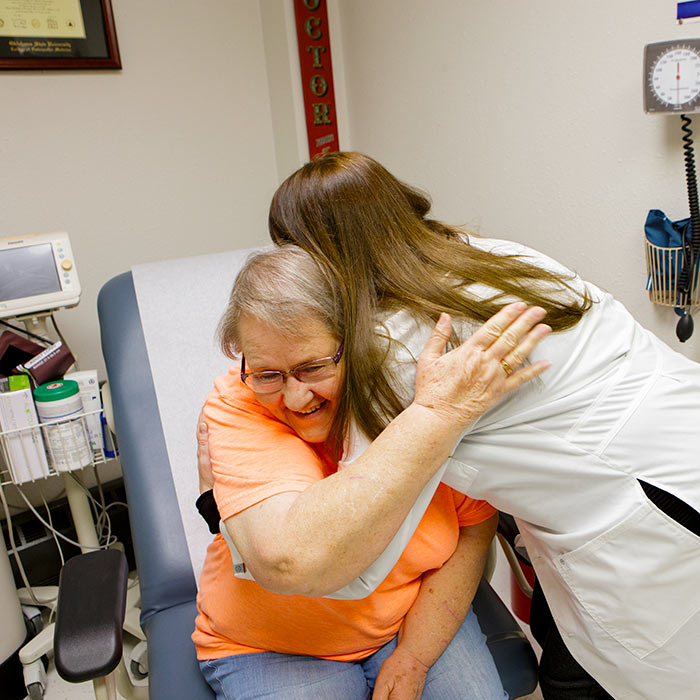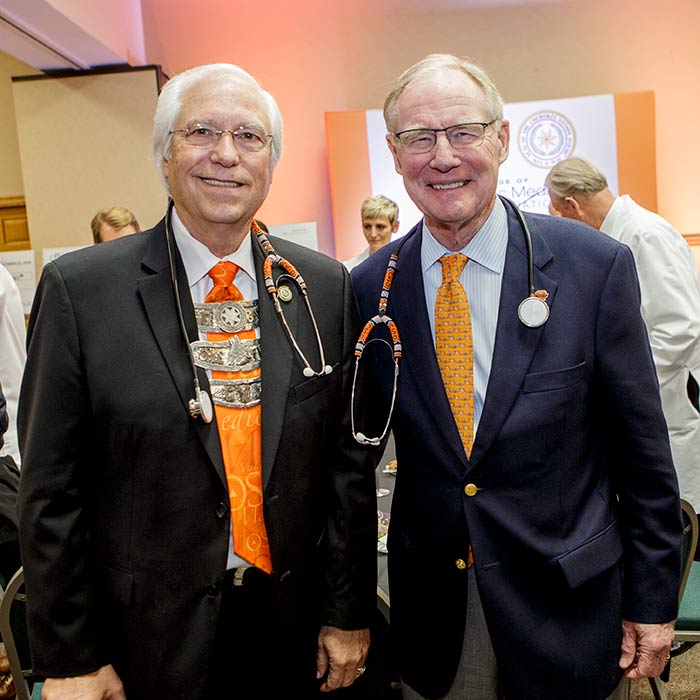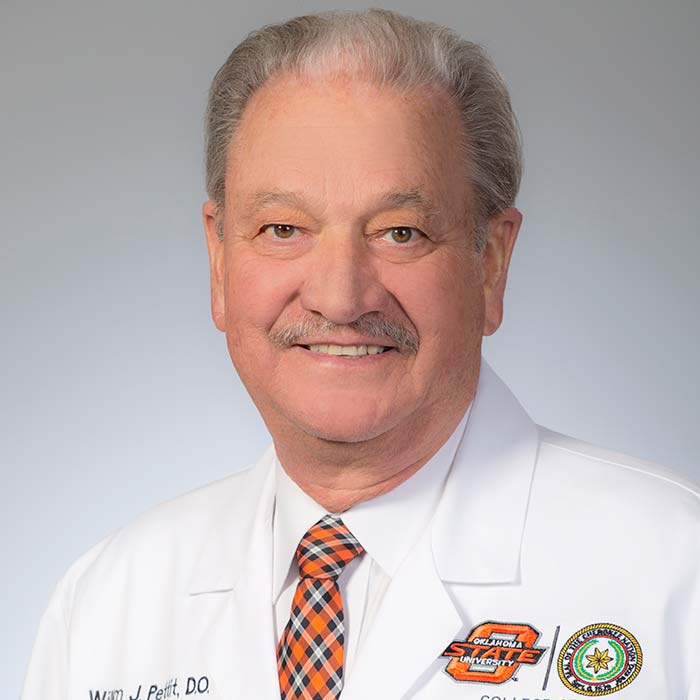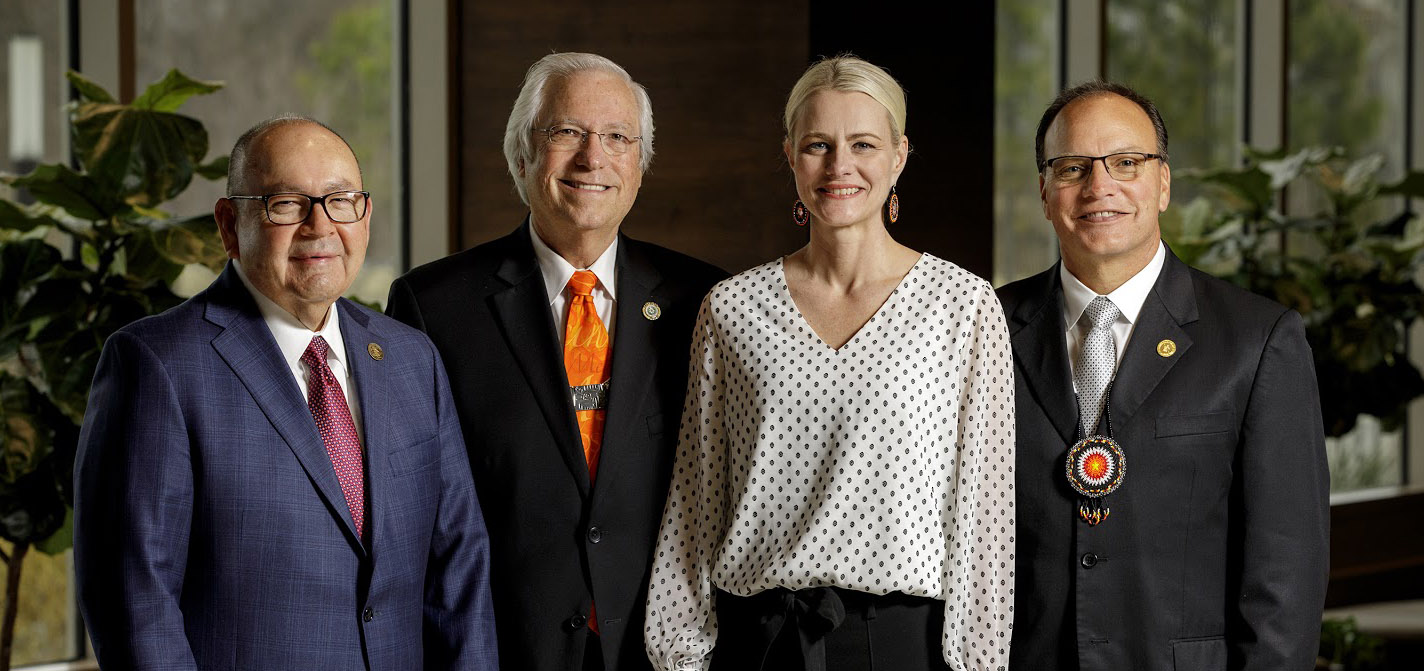
Native Care
Wednesday, May 1, 2019
OSU-CHS teams with the Cherokee Nation on a new medical school
When Dr. Jana Jordan walked into the exam room for her appointment with Mary Williams, she not only asked her patient how she was feeling, but she did it while in the middle of a generous hug.

It’s the usual greeting between the doctor and her patient.
For Williams, who has been a patient with Cherokee Nation Health Services since the 1970s, it’s a level of care and service that she has come to love and expect.
“It’s wonderful. I have health insurance but I choose to come here,” she said. “It’s friendly. You get to know the people, and it’s comfortable.”
Jordan, an OSU College of Osteopathic Medicine alumna, is a primary care physician at the Cherokee Nation’s W.W. Hastings Hospital.
“I started here as a resident 15 years ago. I like the camaraderie of the staff, I like working with the residency program, and I love my patients,” she said.
Jordan is also excited about the new developments happening soon at Cherokee Nation Health Services — the addition of the first tribal-affiliated medical school in the country.
The Plans
In October, the OSU Center for Health Sciences and the Cherokee Nation announced the creation of the OSU College of Osteopathic Medicine at the Cherokee Nation.
The partnership will culminate with the construction of a new, 84,000-square-foot medical school facility on the Cherokee Nation Health Services campus in Tahlequah, Oklahoma. The school is scheduled to open in 2020 with up to 50 students in its inaugural class. There will be space for up to 200 students to be enrolled over the four-year curriculum.
“The Cherokee Nation shares a mission with the OSU College of Osteopathic Medicine to provide primary care physicians for rural and medically underserved areas of the state.”
“What better way to achieve those goals than partnering together to bring a new center of medical learning to this part of Oklahoma?”
The new facility will include an anatomy laboratory, clinical skills lab, osteopathic manipulative medicine lab, standardized patient labs and a simulation center that will feature state-of-the-art computer programmable manikins. There will also be lecture halls, classrooms, faculty offices, study carrels and a gym/workout area.
Cherokee Nation Principal Chief Bill John Baker said establishing the OSU-COM at the Cherokee Nation is the culmination of years of work and is part of the nation’s commitment to making its health care the best in the state.
“Recruiting primary care physicians to practice within the Cherokee Nation’s 14-county jurisdiction remains a constant struggle. We admire and support OSU Center for Health Sciences’ efforts to populate rural Oklahoma with doctors from rural Oklahoma. That mission will create healthier families and communities in northeast Oklahoma and improve the lives of Cherokees for the next seven generations,” he said.
Tribal Care
Being a member of a federally recognized tribe, Williams utilizes its health services — regular doctor visits, medication and specialty care — at no personal cost.
“My friends are saying ‘I have to call on this, or I have to check on that,’ and I don’t have to do anything like that,” she said, adding it’s easier on her bank account. “That’s a plus. Even with insurance, health care is expensive.”
That may be one reason more and more members of federally recognized tribes are utilizing tribal health systems in Oklahoma.

When the Cherokee Nation W.W. Hastings Hospital opened in 1983, it was designed for 63,000 patient care visits a year. In 2018, the hospital had recorded 410,744 patient care visits.
“For us in Cherokee Nation Health Services, the new medical school is a great recruitment opportunity,” Jordan said. “Having the medical school here, we can grow our pool of doctors who are integrated into the community already. We have already recruited a lot of the residents to stay here. The medical school is going to fill a need for physicians, who will in turn help meet the needs of our patients. It will be a great place to have a medical school because we see a lot of complex patients and a number of diverse cases.”
The benefits will go beyond the Cherokee Nation. The Choctaw and Chickasaw nations are dealing with similar issues in their tribal health systems. OSU-COM has residency programs with Choctaw Nation Health Care Center in Talihina, Chickasaw Nation Medical Center in Ada and Northeastern Health Systems in cooperation with the Cherokee Nation W.W. Hastings Hospital in Tahlequah. The residency programs with these tribal health facilities aim to encourage primary care physicians to return to rural and Native communities.
Dr. Ashton Clayborn is a family medicine physician at the Choctaw Nation Health Care Center in Talihina and an alumna of OSU-COM.
“The Choctaw Nation puts a great emphasis on its tribal members and on their health care. If it’s in the patients’ best interest, that’s what my patients get. Working for the system has allowed me to be the physician that I wanted to be, the holistic physician I trained to be, and I can give the best care knowing that all that is available working for a tribal system,” Clayborn said. “The addition of the medical school in Tahlequah will provide an opportunity for rural students to seek an education in a town more similar to the towns where they’ve grown up. I believe it will provide students with a rural background a better opportunity to enter rural residencies and practices in rural locations.”
During her four decades as a patient of Cherokee Nation Health Services, Williams said she’s noticed more patients in the waiting room with her, but she hasn’t seen that diminish the level of care she receives.
“Used to be, there was a stigma to tribal health care, but word has gotten out that they treat you well here, you get good care here,” she said, adding she hopes the addition of the OSU-COM at the Cherokee Nation will mean more doctors for the increasing number of patients. “The partnership of OSU and Cherokee Nation will be a benefit to both. It will draw more people here, and they’ll see it’s a good place to be. It will benefit everyone.”
Leadership Named

To further advance this historic partnership, OSU-CHS named two key leadership positions: William J. Pettit, D.O, M.A., will serve as the inaugural dean, and Natasha Bray, D.O., M.S., is the associate dean for Academic Affairs and Accreditation.
Pettit previously served as provost and senior associate dean of academic affairs for OSU-CHS. Bray most recently served as clinical associate professor in rural health at OSU-CHS. Before joining OSU-CHS, she was the associate dean for the Arkansas College of Osteopathic Medicine.
As dean, Pettit will lead the efforts to identify and recruit biomedical faculty and support staff for the new site and ensure the additional site meets pre-accreditation standards.
“I joined the faculty at OSU Center for Health Sciences in 2002 because I believed in its mission: to train primary care physicians for rural and underserved Oklahoma,” Pettit said. “There is no better place to educate and train future doctors for rural Oklahoma than right here in Tahlequah, where people embrace the rural lifestyle and are rural-minded. I’m excited to have the opportunity and privilege of leading this important endeavor for Oklahoma State University and for Oklahoma.”
| Well Content |
|---|
 Funding ScholarshipsDonors unite to help Native American medical studentsOSU Center for Health Sciences has partnered with the Cherokee, Chickasaw and Choctaw nations as well as 13 private donors to establish multiple scholarship funds totaling more than $475,000 in honor of the OSU College of Osteopathic Medicine at the Cherokee Nation, the first tribal-affiliated medical school in the country. The new medical school is the result of a historic partnership between OSU-CHS and the Cherokee Nation and is set to open in 2020 on the campus of the Cherokee Nation’s W.W. Hastings Hospital in Tahlequah, Oklahoma. The scholarship funds are earmarked for Native American medical students. While the new medical school will be open to all applicants, scholarship dollars designated by donors for Native American medical students will encourage American Indian candidates to pursue medicine at OSU-COM at the Cherokee Nation. “Medical school is a significant investment both in terms of time and money. We are grateful to our many supporters who are partnering with us to train tomorrow’s Native American doctors. I can’t think of a better way to attract more Native American students into medicine than through scholarship dollars,” said Dr. Kayse Shrum, OSU-CHS president and OSU College of Osteopathic Medicine dean. The Cherokee Nation committed $100,000 to support future medical students at OSU-COM at the Cherokee Nation. “When I learned that President Shrum had secured $175,000 in private donations for our new school and that those scholarships would benefit future Cherokee students, I knew that the Cherokee Nation had to join efforts with OSU to grow our own doctors. I am grateful that my good friends, Gov. (Bill) Anoatubby and Chief (Gary) Batton, have also pledged scholarship dollars in honor of this historic announcement. This is a proud moment for all of us in Indian country,” said Bill John Baker, principal chief of the Cherokee Nation. The Chickasaw Nation and Choctaw Nation of Oklahoma each pledged $100,000 to support future Chickasaw and Choctaw citizens in honor of the new partnership and school announcement. “Making this scholarship gift was an easy decision for us. We applaud OSU-CHS’s and the Cherokee Nation’s vision to create the nation’s first tribally affiliated medical school here in Oklahoma. We hope that future Chickasaw students will take the opportunity to study medicine in nearby Tahlequah and then return to practice medicine in the Chickasaw Nation’s 13-county jurisdictional area,” said Anoatubby, governor of the Chickasaw Nation. “It’s an honor to be part of this historic moment and to partner with the Cherokee Nation and the Chickasaw Nation to support OSU in their vision to train tomorrow’s tribal and small town doctors,” said Batton, chief of the Choctaw Nation of Oklahoma. Thirteen private scholarship donors to the new medical school include: Steve and Phyllis Anderson; Robin Flint Ballenger; Mallory Spoor-Baker, D.O. and Damon Baker, D.O.; Natasha Bray, D.O., and Matthew Bray; Marnie and William J. Pettit, D.O.; Beverly and Richard Schafer, D.O.; and Cyndi Wilkett, D.O., and Matt Wilkett, D.O. “For me it has been an honor to help establish a scholarship that combines two mighty nations — the Cherokee Nation and the OSU nation — and I have absolute confidence that my donation will strengthen the futures of both,” said donor Robin Flint Ballenger, president of the Flint Family Foundation and proud member of the Cherokee Nation. “This gift is for me a once-in-a-lifetime chance to be part of a wonderful synergy that will grow and strengthen both the Cherokees and OSU, a partnership that will continue to grow long after I am gone.” The Cherokee, Chickasaw and Choctaw nations have a combined financial impact of $7.2 billion in Oklahoma and are the economic engines for their respective regions. OSU-CHS is the country’s leader in training Native American physicians. Nationally, only 0.2 percent of medical school graduates are American Indian, but at OSU-CHS that percentage is as high as 16 percent some academic years.
|
